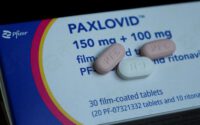Eating seafood may expose you to PFAS: study
Time to scale back on the fish.
People who frequently eat seafood might have an increased risk of exposure to so-called “forever chemicals.”
The toxic chemicals, referred to as PFAS, made headlines earlier this week when the Environmental Protection Agency (EPA) introduced the first national restrictions around levels in drinking water. But experts are now warning that the chemicals — which are pervasive in the soil, water and air — could also be in seafood.
“Our recommendation isn’t to not eat seafood — seafood is a great source of lean protein and omega fatty acids. But it also is a potentially underestimated source of PFAS exposure in humans,” study author Megan Romano, an associate professor of epidemiology at Dartmouth’s Geisel School of Medicine, said in a release. In general, fish is associated with several benefits, including heart, brain and eye health.
The study, which was published in the journal Exposure and Health on Friday, used a statewide survey of eating habits from New Hampshire and paired it with an analysis of PFAS concentrations in fresh seafood. New Hampshire, along with the rest of New England, are the country’s top consumers of seafood — making them ideal for the study.
“Most existing research focuses on PFAS levels in freshwater species, which are not what people primarily eat,” Romano said. “We saw that as a knowledge gap in the literature, especially for a New England state where we know people love their seafood.”
For the study, researchers looked for levels of 26 different PFAS in the most popular types of seafood: cod, haddock, lobster, salmon, scallop, shrimp and tuna. Shrimp and lobster came in at the highest, with 1.74 and 3.30 nanograms per gram of flesh, respectively. Other fish and seafood tested measured generally less than one nanogram per gram.
While researchers aren’t exactly sure how marine life is exposed to PFAS chemicals, they suspect that animals, such as lobsters and shrimp, which both feed on the seafloor, are smaller and live closer to the coast could be more susceptible than larger fish, like tuna, which swim in the open ocean. However, larger fish are not immune, likely because they are eating smaller fish that might contain these chemicals in higher concentrations.
Of the people included in the survey, over 95% said they’d eaten seafood within the past year, while over two-thirds said they’d had fish or shellfish within the past week. Shrimp, haddock and salmon were consumed by more than 70% of the adults who said they ate seafood within the past month. Shrimp consumption was also common among children.
While there are guidelines for safe seafood consumption when it comes to contaminants like mercury, nothing like this exists for PFAS, the researchers noted.
“Top predator species such as tuna and sharks are known to contain high concentrations of mercury, so we can use that knowledge to limit exposure. But it’s less clear for PFAS, especially if you start looking at how the different compounds behave in the environment,” Celia Chen, co-author and research professor in the Department of Biological Sciences at Dartmouth, explained.
PFAS, or Per- and polyfluoroalkyl substances, were initially developed in the 1940s and used across manufacturing — in everything from stain-resistant furniture to non-stick cookware, according to the National Institutes of Health. Over time, those chemicals have leaked into the soil, water and air; and because they’re so slow to break down, most people are exposed to PFAS repeatedly, throughout their lifetime.
Since 1999, the Centers for Disease Control and Prevention (CDC) have looked for PFAS in people’s blood serum and found it to be present in nearly everyone tested. PFAS have even been detected in breastmilk. In other words, some level of exposure to these chemicals is probably unavoidable.
PFAS are associated with cancer, fetal abnormalities, high cholesterol and changes in liver enzymes, among other concerns. Scientists are still investigating the long-term health effects of PFAS exposure, according to the CDC.
The researchers hope their study will encourage the establishment of safety guidelines for those who might be especially susceptible to pollutants, Kathryn Crawford, an assistant professor of environmental studies at Middlebury College, said in the release. But the scientists stressed these findings do not imply everyone needs to stop eating seafood altogether.
“People who eat a balanced diet with more typical, moderate amounts of seafood should be able to enjoy the health benefits of seafood without excessive risk of PFAS exposure,” Crawford said.


